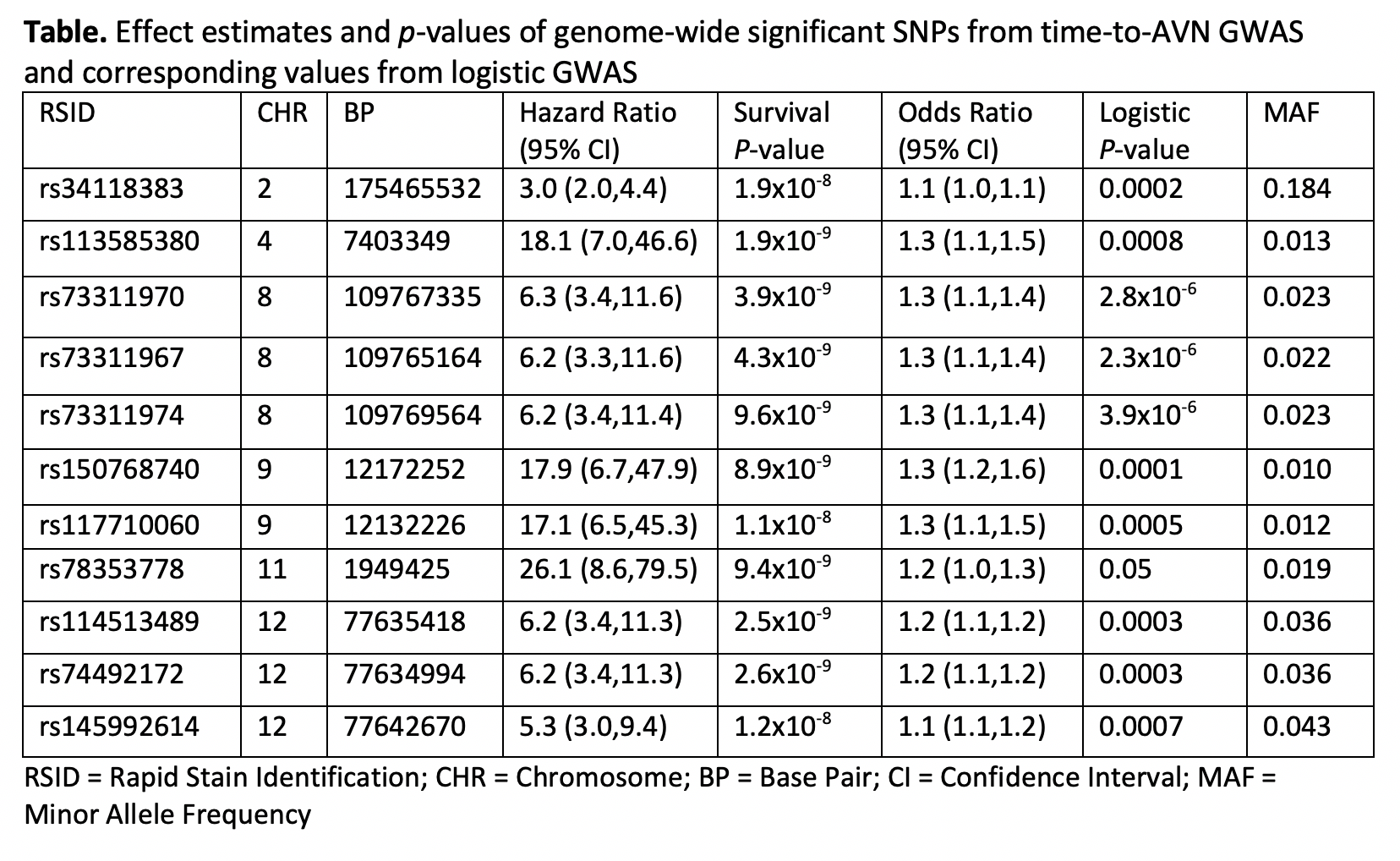Session Information
Date: Saturday, November 7, 2020
Title: SLE – Diagnosis, Manifestations, & Outcomes I: Morbidity (0980–0984)
Session Type: Abstract Session
Session Time: 5:00PM-5:50PM
Background/Purpose: Genetics have been shown to contribute to risk of avascular necrosis (AVN), a debilitating complication of systemic lupus erythematosus (SLE). Our aim was to identify genetic risk loci for AVN in people with childhood-onset (cSLE) and adult-onset SLE (aSLE).
Methods: The study consisted of patients with SLE from two tertiary care centres. Participants all met ≥4 of the ACR/SLICC classification criteria for SLE. All participants had prospectively collected clinical data and were genotyped on the Illumina multiethnic array. Ungenotyped SNPs were imputed and ancestry was inferred using principal components (PCs) (1000 Genomes Project reference). The outcome was defined as symptomatic AVN confirmed by imaging (radiograph, CT, bone scan and/or MRI). GWAS of AVN using both time-to-event analysis and logistic regression were conducted with follow-up truncated at 20 years. Models were adjusted for sex, age of SLE diagnosis, cSLE vs. aSLE, PCs, lupus nephritis status, exposure to high dose glucocorticoids, and time from SLE diagnosis to first clinic appointment. High dose glucocorticoids were defined as ≥40 mg/day or ≥2 mg/kg body weight per day (for pediatrics) for at least 30 days. A genome-wide significance threshold (p< 5x10-8) was used to indicate statistical significance.
Results: The cohort included 940 individuals with SLE (56% cSLE). The median age of SLE diagnosis was 16.9 years (IQR=15.8) and 87% were female. 71 patients (8%) had imaging-confirmed AVN. Among AVN cases, 82% met the definition for high-dose glucocorticoid exposure compared to 46% of non-AVN patients. In the multivariate time-to-event GWAS, 11 SNPs met the genome-wide significance threshold. The hazard ratios for these significant SNPs ranged from 3.0 (95%CI: 2.4, 4.0) to 26.1 (95% CI: 8.6, 79.5) (Table). These SNPs represented 6 independent loci predictive of earlier AVNinkage disequilibrium < 0.8), with minor allele frequencies (MAF) from 1-18%. Of these SNPs, 3 were linked with genes: WIPF1, TMEM74, and LOC105375976. No SNPs met genome-wide significance in multivariate logistic GWAS with AVN.
Conclusion:
Six independent SNPs were found to be significantly associated with decreased time to AVN, in children and adults with SLE. All variants were rare (MAF< 0.05) with the exception of rs34118383 (Chr2), an intronic variant of the WIPF1 gene (MAF=0.18). WIPF1 encodes a protein essential in the formation of podosomes, actin-rich adhesive structures which are necessary for osteoclast-mediated bone resorption. TMEM74 is involved in the induction of autophagy, a form of programmed cell death, which is necessary for osteoblast and osteoclast homeostasis. These SNPs have not been previously associated with AVN-risk in SLE or non-SLE populations. Future studies are required to replicate these findings in independent cohorts.
To cite this abstract in AMA style:
Webber D, Cao J, Dominguez D, Gladman D, Knight A, Levy D, Ng L, Paterson A, Touma Z, Urowitz M, Wither J, Silverman E, Hiraki L. Genetics of Avascular Necrosis in Children and Adults with Systemic Lupus Erythematosus [abstract]. Arthritis Rheumatol. 2020; 72 (suppl 10). https://acrabstracts.org/abstract/genetics-of-avascular-necrosis-in-children-and-adults-with-systemic-lupus-erythematosus/. Accessed .« Back to ACR Convergence 2020
ACR Meeting Abstracts - https://acrabstracts.org/abstract/genetics-of-avascular-necrosis-in-children-and-adults-with-systemic-lupus-erythematosus/

